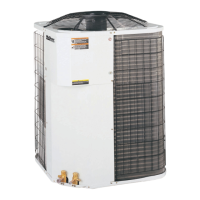IOMM ACZ1 ACZ 010A through 039A
7
3.
Manual or automatic air vent valves at the high points of the system. Install drains at the lowest
points in the system.
4.
A means of maintaining adequate system water pressure (expansion tank or regulating valve).
5.
Temperature and pressure indicators located at the unit to aid in unit servicing. Pressure gauge
taps must be installed in the chilled water inlet and outlet piping or as shown in Figure 4.
6.
A strainer or other means of removing foreign matter from the water before it enters the pump.
Place the strainer far enough upstream to prevent cavitation at the pump inlet (consult pump
manufacturer for recommendations). The use of a strainer will help prolong pump life and keep
system performance up.
7.
A 40-mesh strainer is required in the water line just before the inlet of the evaporator. This will
help prevent foreign material from entering and decreasing the performance of the evaporator.
8.
If the unit is used as a replacement chiller on a previously existing piping system, flush the
system thoroughly before unit installation. Regular water analysis and chemical water treatment
on the evaporator is recommended immediately at equipment start-up.
9.
When glycol is added to the water system for freeze protection, the refrigerant suction pressure
will be lower, cooling performance less, and water side pressure drop greater. If the percentage
of glycol is high, or if propylene is used instead of ethylene glycol, the added pressure drop and
loss of performance could be substantial. Reset the freezestat and low leaving water alarm
temperatures. The freezestat is factory set to default at 38°F (3.3°C). Reset the freezestat setting
to approximately 4 to 5 degrees F (2.3 to 2.8 degrees C) below the leaving chilled water setpoint
temperature.
10.
Perform a preliminary leak check before insulating the piping and filling the system.
11.
Piping insulation should include a vapor barrier to prevent condensation and possible damage to
the building structure.
Figure 4, Typical Field Evaporator Water Piping
Air
Vent
Flow
Switch
Vibration
Eliminators
Drain
Outlet
Inlet
P
Isolation
Valves
Strainer
System Volume
It is important to have adequate water volume in the system to provide an opportunity for the chiller
to sense a load change, adjust to the change and stabilize. As the expected load change becomes
more rapid, a greater water volume is needed. The system water volume is the total amount of water
in the evaporator, air handling products and associated piping. If the water volume is too low,
operational problems can occur, including rapid compressor cycling, rapid loading and unloading of
compressors, erratic refrigerant flow in the chiller, improper motor cooling, shortened equipment life
and other undesirable occurrences.

